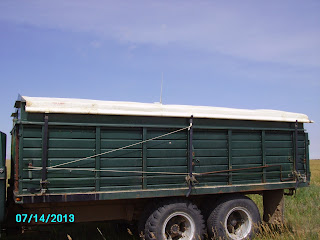For the first time since 1988, wheat harvest has come to the old
farm. A combine I bought in 1990 (maybe
1991) which was 25 years old then, has been put to use on my crop instead of
being used for custom hire.
The combine, born in 1964, is now 49 years old. It hasn’t done anything but sit in the shed
since 2006. It’s out and ready to go.
Both trucks had to be vetted, brake lines bled, hoist and gear box oil
checked, u-joints and steering greased, and tires aired. Those ablutions
require a lot of rolling around under the trucks, which seems to take a lot
more energy than it used to.
Oh yes, and mouse droppings removed from cab and under the hood. The shop vacuum makes that job much
easier. I used to have to try to blow
everything out with air pressure. You don't get the "repercussions" with a vacuum.
The grain bin took a little while, too. I’ve never got electricity to the bin, so shop vac need not apply. Brooms and shovels with dust mask. Get it clean, then caulk the base to try to keep the water out. Finally, spray a little disinfectant to kill the weevils and other such vermin. I used vinegar this time. We’ll see how that works out. The hardest part is getting in and out of the thing.
Uncle Ricky and I erected the bin. We dug the hole, formed it up, and poured the
cement. The concrete record attests to
the date. We also did the bin-raising.
The neighbors have used the bin a couple
of times in the past 20 years. I used it
once when the elevators got full and I didn’t want to set in a line of trucks
waiting to unload. That was in my
custom-cutting days. I dumped into
it. As soon as I was done harvesting,
and everyone else, too, I hauled the wheat to town.
The auger works, finally. It took
about as much time as the combine to get ready.
It hasn’t done anything but sit outside for ten years. Here it is on its way up to the top of the
bin.
Well, now for the bad news. I will have plenty of room in the grain bin
for this year’s crop. I cut a sample on
Tuesday, July 9.
I
couldn’t get it tested till Wednesday.
It tested 10.3% moisture. (Below
13% moisture is considered safe to bin without worrying about spoilage.)
So harvest began Wednesday about 3 p. m., after I changed a hydraulic
hose on the combine. It rained about .1”
around 4:30. That shut me down.
Thursday, I spent most of the morning getting the auger positioned in
the bin. Quite a job for one person.
I cut all afternoon Thursday and got the big truck loaded. I took most of the morning Friday to unload
the truck. I cut another truck load
Friday afternoon. I had to quit early so
I could go to town to listen to The
Mixers play for the local cancer walkathon.
That gave me the chance to visit with band member and Nephew Rich and
his daughter Eleanor. I lasted till about 10:30. But the band played on--till midnight, if thy remained true to the schedule.
Saturday morning I unloaded the truck for a second time. Things went a lot better and I was back in
the field by 11 a. m. A “can’t miss”
thunderstorm lined up in the west. So I quit about 4 and battened down the
hatches.
That’s where I am today. I’m over
half done with about 300 bushels on the truck.
I may have another 6 or 7 hundred bushels left in the field. That will figure out to be somewhere between
10 and 15 bushels to the acre. Not
exactly a bumper crop.













































